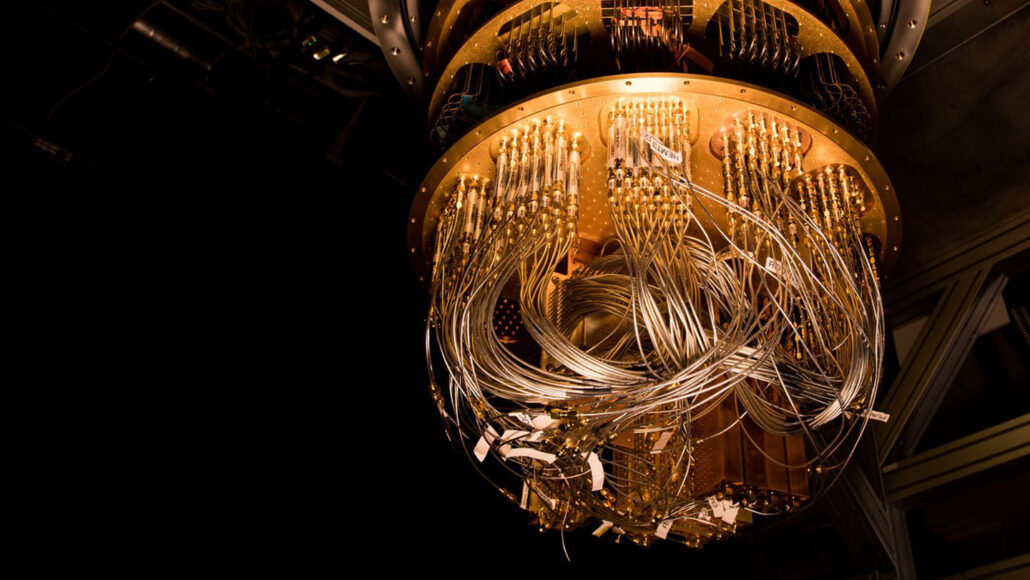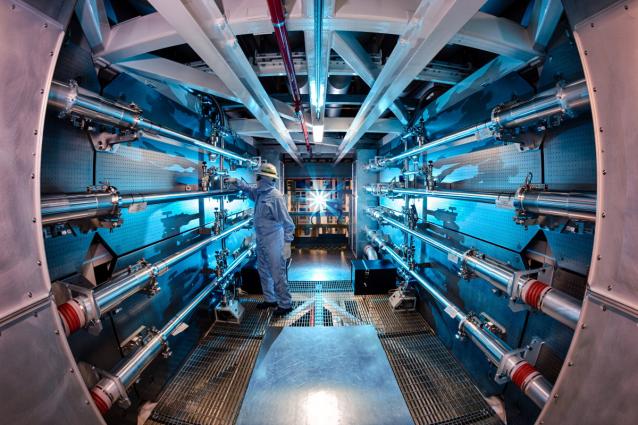Physics forged ahead in 2022, making a wide range of advances. From a telescope far out in space to a telescope that spans the size of the Earth, from solid state physics and quantum computing at ultra-low temperatures to particle and nuclear physics at ultra-high energies, the year saw a number of firsts. Here’s a list of eight discoveries of 2022 that define the frontiers of physics.
James Webb Space Telescope
“First Light” has two meanings: the “First Light” that originated at the beginning of the universe, and the “First Light” that is collected by a new telescope. In the beginning of this year, the the James Webb Space Telescope (JWST) saw both types of first light, and with it came first surprises.

The JWST has found that galaxies are too well formed too early in the universe relative to current models of galaxy formation. Almost as soon as the JWST began forming images, it acquired evidence of massive galaxies from only a few hundred million years old. Existing theories of galaxy formation did not predict such large galaxies so soon after the Big Bang.
Another surprise came from images of the Southern Ring Nebula. While the Hubble did not find anything unusual about this planetary nebula, the JWST found cold dust surrounding the white dwarf that remained after the explosion of the supernova. This dust was not supposed to be there, but it may be coming from a third member of the intra-nebular environment. In addition, the ring-shaped nebula contained masses of swirling streams and ripples that are challenging astrophysicists who study supernova and nebula formation to refine their current models.
Quantum Machine Learning
Machine learning—the training of computers to identify and manipulate complicated patterns within massive data—has been on a roll in recent years, ever since efficient training algorithms were developed in the early 2000’s for large multilayer neural networks. Classical machine learning can take billions of bits of data and condense it down to understandable information in a matter of minutes. However, there are types of problems that even conventional machine learning might take the age of the universe to calculate, for instance calculating the properties of quantum systems based on a set of quantum measurements of the system.
In June of 2022, researchers at Caltech and Google announced that a quantum computer—Google’s Sycamore quantum computer—could calculate properties of quantum systems using exponentially fewer measurements than would be required to perform the same task using conventional computers. Quantum machine learning uses the resource of quantum entanglement that is not available to conventional machine learning, enabling new types of algorithms that can exponentially speed up calculations of quantum systems. It may come as no surprise that quantum computers are ideally suited to making calculations of quantum systems.

A Possible Heavy W Boson
High-energy particle physics has been in a crisis ever since 2012 when they reached the pinnacle of a dogged half-century search for the fundamental constituents of the universe. The Higgs boson was the crowning achievement, and was supposed to be the vanguard of a new frontier of physics uncovered by CERN. But little new physics has emerged, even though fundamental physics is in dire need of new results. For instance, dark matter and dark energy remain unsolved mysteries despite making up the vast majority of all there is. Therefore, when physicists at Fermilab announced that the W boson, a particle that carries the nuclear weak interaction, was heavier than predicted by the Standard Model, some physicists heaved sighs of relief. The excess mass could signal higher-energy contributions that might lead to new particles or interactions … if the excess weight holds up under continued scrutiny.

Imaging the Black Hole at the Center of the Milky Way
Imagine building a telescope the size of the Earth. What could it see?
If it detected in the optical regime, it could see a baseball on the surface of the Moon. If it detected at microwave frequencies, then it could see the material swirling around distant black holes. This is what the Event Horizon Telescope (EHT) can do. In 2019, it revealed the first image of a black hole: the super-massive black hole at the core of the M87 galaxy 53 million light years away. They did this Herculean feat by combining the signals of microwave telescopes from across the globe, combining their signals interferometrically to create an effective telescope aperture that was the size of the Earth.
The next obvious candidate was the black hole at the center of our own galaxy, the Milky Way. Even though our own black hole is much smaller than the one in M87, ours is much closer, and both subtend about the same solid angle. The challenge was observing it through the swirling stars and dust at the core of our galaxy. In May of this year, the EHT unveiled the first image of our own black hole, showing the radiation emitted by the in-falling material.

Tetraneutrons
Nuclear physics is a venerable part of modern physics that harkens back to the days of Bohr and Rutherford and the beginning of quantum physics, but in recent years it has yielded few new surprises (except at the RHIC collider which smashes heavy nuclei against each other to create quark-gluon plasma). That changed in June of 2022, when researchers in Germany announced the successful measurement of a tetraneutron–a cluster of four neutrons bound transiently together by the strong nuclear force.
Neutrons are the super-glue that holds together the nucleons in standard nuclei. The force is immense, strong enough to counteract the Coulomb repulsion of protons in a nucleus. For instance, Uranium 238 has 92 protons crammed within a volume of about 10 femtometer radius. It takes 146 neutrons to bind these together without flying apart. But neutrons don’t tend to bind to themselves, except in “resonance” states that decay rapidly. In 2012, a dineutron (two neutrons bound in a transient resonance state) was observed, but four neutrons were expected to produce an even more transient resonance (a three-neutron state is not allowed). When the German group created the tetraneutron, it had a lifetime of only about 1×10-21 seconds, so it is extremely ephemeral. Nonetheless, studying the properties of the tetraneutron may give insights into both the strong and weak nuclear forces.
Hi-Tc superconductivity
When Bednorz and Müller discovered Hi-Tc superconductivity in 1986, it set off both a boom and a crisis. The boom was the opportunity to raise the critical temperature of superconductivity from 23 K that had been the world record held by Nb3Ge for 13 years since it was set in 1973. The crisis was that the new Hi-Tc materials violated the established theory of superconductivity explained by Bardeen-Cooper-Schrieffer (BCS). There was almost nothing in the theory of solid state physics that could explain how such high critical temperatures could be attained. At the March Meeting of the APS the following year in 1987, the session on the new Hi-Tc materials and possible new theories became known as the Woodstock of Physics, where physicists camped out in the hallway straining their ears to hear the latest ideas on the subject.
One of the ideas put forward at the session was the idea of superexchange by Phil Anderson. The superexchange of two electrons is related to their ability to hop from one lattice site to another. If the hops are coordinated, then there can be an overall reduction in their energy, creating a ground state of long-range coordinated electron hopping that could support superconductivity. Anderson was perhaps the physicist best situated to suggest this theory because of his close familiarity with what was, even then, known as the Anderson Hamiltonian that explicitly describes the role of hopping in solid-state many-body phenomena.
Ever since, the idea of superexchange has been floating around the field of Hi-Tc superconductivity, but no one had been able to pin it down conclusively, until now. In a paper published in the PNAS in September of 2022, an experimental group at Oxford presented direct observations of the spatial density of Cooper pairs in relation to the spatial hopping rates—where hopping was easiest then the Cooper pair density was highest, and vice versa. This experiment provides almost indisputable evidence in favor of Anderson’s superexchange mechanism for Cooper pair formation in the Hi-Tc materials, laying to rest the crisis launched 36 years ago.
Holographic Wormhole
The holographic principle of cosmology proposes that our three-dimensional physical reality—stars, galaxies, expanding universe—is like the projection of information encoded on a two-dimensional boundary—just as a two-dimensional optical hologram can be illuminated to recreate a three-dimensional visual representation. This 2D to 3D projection was first proposed by Gerald t’Hooft, inspired by the black hole information paradox in which the entropy of a black hole scales as surface area of the black hole instead of its volume. The holographic principle was expanded by Leonard Susskind in 1995 based on string theory and is one path to reconciling quantum physics with the physics of gravitation in a theory of quantum gravity—one of the Holy Grails of physics.
While it is an elegant cosmic idea, the holographic principle could not be viewed as anything down to Earth, until now. In November 2022 a research group at Caltech published a paper in Nature describing how they used Google’s Sycamore quantum computer (housed at UC Santa Barbara) to manipulate a set of qubits into creating a laboratory-based analog of a Einstein-Rosen bridge, also known as a “wormhole”, through spacetime. The ability to use quantum information states to simulate a highly-warped spacetime analog provides the first experimental evidence for the validity of the cosmological holographic principle. Although the simulation did not produce a physical wormhole in our spacetime, it showed how quantum information and differential geometry (the mathematics of general relativity) can be connected.
One of the most important consequences of this work is the proposal that ER = EPR (Einstein-Rosen = Einstein-Podolsky-Rosen). The EPR paradox of quantum entanglement has long been viewed as a fundamental paradox of physics that requires instantaneous non-local correlations among quantum particles that can be arbitrarily far apart. Although EPR violates local realism, it is a valuable real-world resource for quantum teleportation. By demonstrating the holographic wormhole, the recent Caltech results show how quantum teleportation and gravitational wormholes may arise from the same physics.
Net-Positive-Energy from Nuclear Fusion
Ever since nuclear fission was harnessed to generate energy, the idea of tapping the even greater potential of nuclear fusion to power the world has been a dream of nuclear physicists. Nuclear fusion energy would be clean and green and could help us avoid the long-run disaster of global warming. However, achieving that dream has been surprisingly frustrating. While nuclear fission was harnessed for energy (and weapons) within only a few years of discovery, and a fusion “boost” was added to nuclear destructive power in the so-called hydrogen bomb, sustained energy production from fusion has remained elusive.
In December of 2022, the National Ignition Facility (NIF) focussed the power of 192 pulsed lasers onto a deuterium-tritium pellet, causing it to implode, and the nuclei to fuse, releasing about 50% more energy that it absorbed. This was the first time that controlled fusion released net positive energy—about 3 million Joules out from 2 million Joules in—enough energy to boil about 3 liters of water. This accomplishment represents a major milestone in the history of physics and could one day provide useful energy. The annual budget of the NIF is about 300 million dollars, so there is a long road ahead (probably several more decades) before this energy source can be scaled down to an economical level.

By David D. Nolte Jan. 16, 2023

